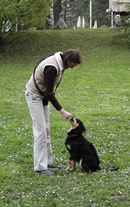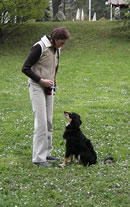Top Ten Dog Training Tips
1. Have fun.
If you have fun training your dog then he too will enjoy his training.
Dogs learn best when they are relaxed and enjoying themselves. They can also pick up on the mood of their handler and will often mirror it. Try to make all your training fun for you and your dog.
2. If you get frustrated, take a break.
If you find that a training session is not going well and that you are getting frustrated or angry, it is usually best to take a break and try again later.
Training your dog can sometimes be frustrating. There will be times when it feels as if nothing is going right or that your dog has forgotten everything he learnt the day before. This may be because your dog is tired or feeling a little off colour. They have their bad days just as we do. Whatever the reason, try to end the session on a good note by asking your dog to do something easy that he knows well (maybe a "Sit") and then call it a day.
3. Be more interesting to your dog than the distractions around you.
One of the biggest challenges we face when training our dogs is getting their attention.
People often find that their dog will behave beautifully at home or in the garden but that it all falls apart in the park. This is because the distractions out on a walk are more interesting to him than his owner. So how can you get his attention? Different dogs are motivated by different things so try using different rewards (see tip 4 below). Also the more dynamic you are, the more interesting you will be - try jumping around, making high pitched noises, running away, clapping your hands or lying down. You may feel a bit of a fool but your dog will be intrigued!
4. Find out what motivates your dog.
Different dogs are motivated by different types of rewards.
Some are very food-motivated while others prefer toys. Individuals will also have their favourite types of food or toys. You will need to experiment with your dog to find out which rewards hold the highest value for him. Some suggestions are below but use your imagination as I’ve seem some dogs who are motivated by the strangest things!
- Food treats: hot dog, liver cake, pilchard cake, ham, chicken, dried fish, dry biscuits, commercially-produced treats.
- Toys: tennis balls, rubber balls, tug toys, squeaky toys, soft toys, chew toys.
Dogs also love novelty so aim for variety in your rewards. For example if your dog loves squeaky toys, keep three or four of them hidden away and only bring them out when you do some training or go for a walk. Use a different toy each time to make them even more exciting. If he loves food, use hot dog one day and chicken the next so he never knows what tasty treat is coming his way. Also, always cut food treats into very small pieces so that he does not get full too quickly.
5. Don’t ask your dog to do something if you don’t have his attention.
In other words, you should always aim to set yourself up for success.
Make sure that you have your dog’s attention before asking him to do something. Otherwise you will just have to repeat the command and he will quickly learn to ignore your first or second command.
Imagine that you are in the garden with your dog and you want to practise the down position. He has just found an interesting smell on the ground and is investigating it. If you give the “Down” command at this moment he will probably ignore you. Instead, say his name enthusiastically and move him away from the interesting smell and then give the command.
6. Be consistent.
A dog will learn much more quickly and reliably if you are consistent with him. In particular, the following areas make a big difference:
- Choose a particular verbal command or hand signal for a behaviour and stick to it. For example, if you call your dog using “Come” one day and “Here” the next, you will confuse him.
- Make sure that all members of the family use the same commands.
- Avoid ambiguous commands as they will confuse your dog. For example, if you say “Down” to your dog when he jumps up then do not use “Down” to mean lie down as well. It is better to choose a different word for lie down such as “Lay” or “Flat”.
7.Practise little & often.
Training can be tiring for your dog, especially if he is a young puppy or a rescue dog that is not used to training, so keep your sessions short. When he gets tired he will not be able to concentrate and is likely to start misbehaving. For this reason it is better to train your dog for five or ten minutes each day than to train him for an hour once a week.
8. Only say your command once.
Repeating your commands teaches your dog to respond when he is ready, not when you want him to.
Humans have a tendency to nag when they tell someone to do something. You should train yourself to give a command once and once only, and your expectation should be that the dog will respond first time. If your dog does not respond first time, then ask yourself the following questions: Does he understand the command or do you need to practise it some more? Are your rewards motivating enough for him? Did you get his attention before giving the command? Are you making training too difficult for him, too quickly?
9. Practise your training in different places.
Dogs do not generalise easily.
This means that if he learns to do something in one particular location (e.g. your kitchen) it does not automatically mean that he will do it reliably in another location (e.g. your garden). Therefore if you are teaching your dog something new, once he has understood it in the kitchen you will need to teach him again when you move into the garden. He should however understand the new command more quickly in the garden, having learnt it previously in the kitchen. If you then want to practise the command somewhere more challenging, such as the park, you will need to teach him again. This time he should understand what is required even more quickly than he did in the garden (but there will be more distractions so this will not necessarily be the case). A good rule of thumb is that you need to practise a behaviour in three different locations before the dog will understand the command wherever he is.
10. Think like a dog.
The more you can understand how dogs think and communicate, the more successful your training will be.
Dogs do not think or communicate in the same way as we do. In all your training, try to look at what you are doing from your dog’s perspective. This will reap huge rewards both in terms of your training and your relationship with your dog.







